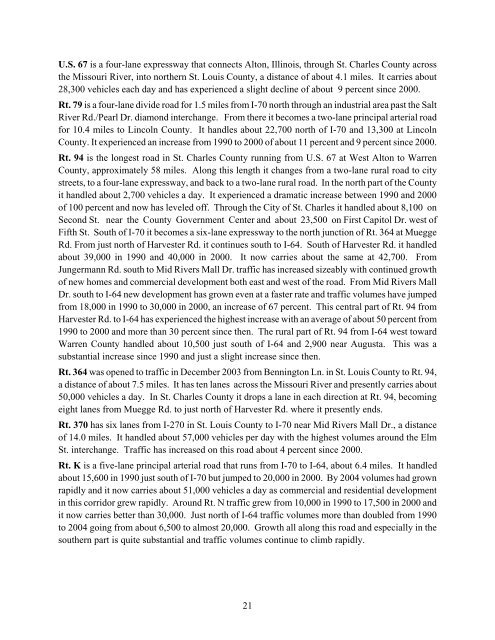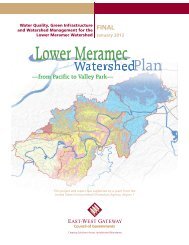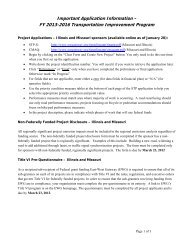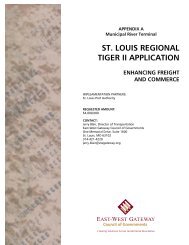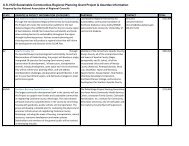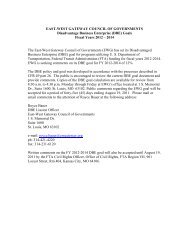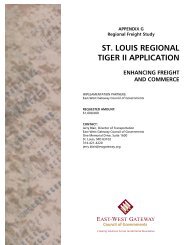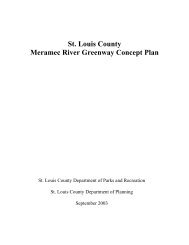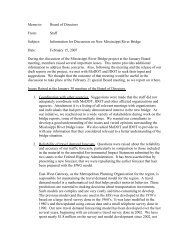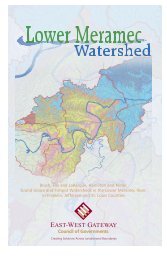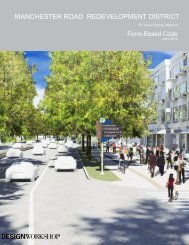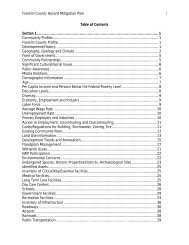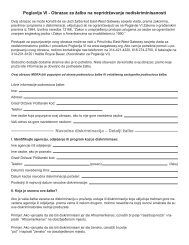St. Charles County Transportation Plan 2030 - East-West Gateway ...
St. Charles County Transportation Plan 2030 - East-West Gateway ...
St. Charles County Transportation Plan 2030 - East-West Gateway ...
Create successful ePaper yourself
Turn your PDF publications into a flip-book with our unique Google optimized e-Paper software.
U.S. 67 is a four-lane expressway that connects Alton, Illinois, through <strong>St</strong>. <strong>Charles</strong> <strong>County</strong> across<br />
the Missouri River, into northern <strong>St</strong>. Louis <strong>County</strong>, a distance of about 4.1 miles. It carries about<br />
28,300 vehicles each day and has experienced a slight decline of about 9 percent since 2000.<br />
Rt. 79 is a four-lane divide road for 1.5 miles from I-70 north through an industrial area past the Salt<br />
River Rd./Pearl Dr. diamond interchange. From there it becomes a two-lane principal arterial road<br />
for 10.4 miles to Lincoln <strong>County</strong>. It handles about 22,700 north of I-70 and 13,300 at Lincoln<br />
<strong>County</strong>. It experienced an increase from 1990 to 2000 of about 11 percent and 9 percent since 2000.<br />
Rt. 94 is the longest road in <strong>St</strong>. <strong>Charles</strong> <strong>County</strong> running from U.S. 67 at <strong>West</strong> Alton to Warren<br />
<strong>County</strong>, approximately 58 miles. Along this length it changes from a two-lane rural road to city<br />
streets, to a four-lane expressway, and back to a two-lane rural road. In the north part of the <strong>County</strong><br />
it handled about 2,700 vehicles a day. It experienced a dramatic increase between 1990 and 2000<br />
of 100 percent and now has leveled off. Through the City of <strong>St</strong>. <strong>Charles</strong> it handled about 8,100 on<br />
Second <strong>St</strong>. near the <strong>County</strong> Government Center and about 23,500 on First Capitol Dr. west of<br />
Fifth <strong>St</strong>. South of I-70 it becomes a six-lane expressway to the north junction of Rt. 364 at Muegge<br />
Rd. From just north of Harvester Rd. it continues south to I-64. South of Harvester Rd. it handled<br />
about 39,000 in 1990 and 40,000 in 2000. It now carries about the same at 42,700. From<br />
Jungermann Rd. south to Mid Rivers Mall Dr. traffic has increased sizeably with continued growth<br />
of new homes and commercial development both east and west of the road. From Mid Rivers Mall<br />
Dr. south to I-64 new development has grown even at a faster rate and traffic volumes have jumped<br />
from 18,000 in 1990 to 30,000 in 2000, an increase of 67 percent. This central part of Rt. 94 from<br />
Harvester Rd. to I-64 has experienced the highest increase with an average of about 50 percent from<br />
1990 to 2000 and more than 30 percent since then. The rural part of Rt. 94 from I-64 west toward<br />
Warren <strong>County</strong> handled about 10,500 just south of I-64 and 2,900 near Augusta. This was a<br />
substantial increase since 1990 and just a slight increase since then.<br />
Rt. 364 was opened to traffic in December 2003 from Bennington Ln. in <strong>St</strong>. Louis <strong>County</strong> to Rt. 94,<br />
a distance of about 7.5 miles. It has ten lanes across the Missouri River and presently carries about<br />
50,000 vehicles a day. In <strong>St</strong>. <strong>Charles</strong> <strong>County</strong> it drops a lane in each direction at Rt. 94, becoming<br />
eight lanes from Muegge Rd. to just north of Harvester Rd. where it presently ends.<br />
Rt. 370 has six lanes from I-270 in <strong>St</strong>. Louis <strong>County</strong> to I-70 near Mid Rivers Mall Dr., a distance<br />
of 14.0 miles. It handled about 57,000 vehicles per day with the highest volumes around the Elm<br />
<strong>St</strong>. interchange. Traffic has increased on this road about 4 percent since 2000.<br />
Rt. K is a five-lane principal arterial road that runs from I-70 to I-64, about 6.4 miles. It handled<br />
about 15,600 in 1990 just south of I-70 but jumped to 20,000 in 2000. By 2004 volumes had grown<br />
rapidly and it now carries about 51,000 vehicles a day as commercial and residential development<br />
in this corridor grew rapidly. Around Rt. N traffic grew from 10,000 in 1990 to 17,500 in 2000 and<br />
it now carries better than 30,000. Just north of I-64 traffic volumes more than doubled from 1990<br />
to 2004 going from about 6,500 to almost 20,000. Growth all along this road and especially in the<br />
southern part is quite substantial and traffic volumes continue to climb rapidly.<br />
21


